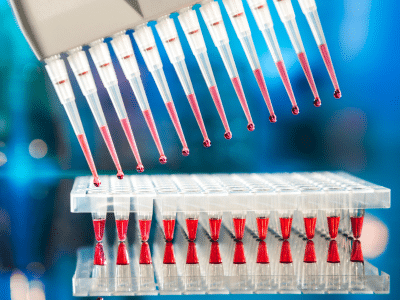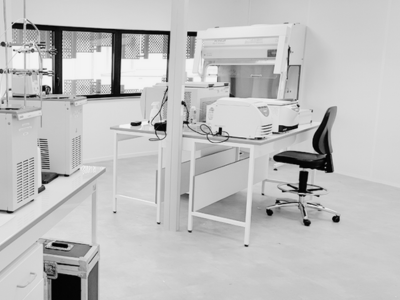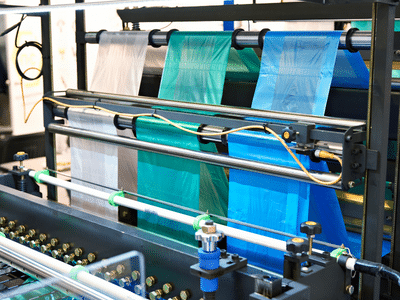This blog entry is aimed at providing technical information on the measurement strategy, installation, performance, operation and general framework of the new dynamic temperature characterisation method of a crown developed by LABELIANS smart service metrology laboratory.
1. Definition of measurer :
The measurer is a dynamic measurement of the air temperature at a stable rotation speed at the critical points of the hollow cylinder drawn by the mobile assembly (racks) hosting the samples.
On the one hand, we demonstrate that the nature of the samples has no impact on the average temperature at each point of the system (the only phenomenon observed is a decrease in the amplitude of the oscillations).
On the other hand, it has been shown that the critical points are located at the edges of the system (location of hot and cold points varies according to the centrifuge models) and that the temperature heterogeneity is identical in each rack (which allows the sensors to be distributed in the different racks of the installation).
2. Installation :
Case of a free rotor: the sensors are positioned at the bottom and flush with the tube housings and distributed in the 4 racks of the rotor assembly. They can be shown on a single rack:
Conditions of use that have an impact on the thermal behaviour:
- use or not of casings
- speed of rotation
- acquisition frequency must be adapted to the duration of the programmes used (from 5 to 30 minutes), the oscillations, the data used
- Consistent value: 10s
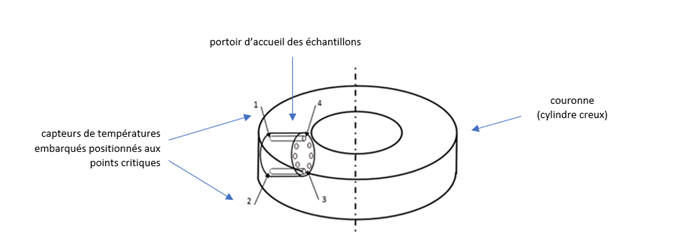
Dynamic diagram of a rack for installation in a free rotor (star rotor)
3. Established and transitional regimes
The transient study is used to validate the strategy for preconditioning the equipment and its accessories (the stage prior to centrifugation).
Generally, two strategies are adopted: storage of the racks in a thermostatic chamber (with the samples) or in the centrifuge (with the rotor assembly components). Control of this stage is essential, as the heat exchange between the samples and the racks is very rapid and very important due to the large thermal mass.
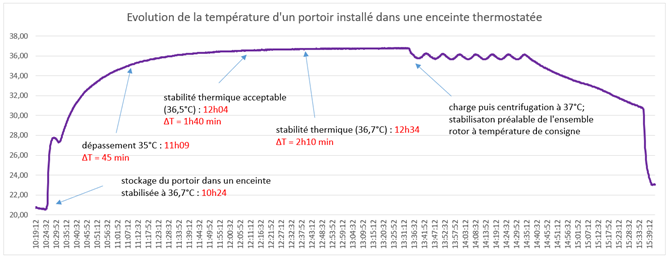
Thermal stabilization of a rack from ambient temperature to 37 ° C
Monitoring of the temperature at the 4 critical points of the system: prior established regime in enclosure – load simulation – transient regime then recovery of an established regime:

Example of a transient report study at 37 ° C
Main information delivered on the transient report :
- Pre-conditioning strategy
- Duration of the disturbance (simulated load time)
- Recovery time from steady state
- Maximum measured value and duration of overshoot, if any
The study of the established regime makes it possible to rule on the conformity of the equipment.
Main information delivered on the established scheme reports:
For each measurement point (each sensor j) :
- average value (θmj) ;
- standard deviation (sj) ;
- compound uncertainty (ucj) ;
- expanded uncertainty (Umj = umj * k).
- desired temperature (θdes) ;
- average air temperature in the chamber = space-time average (θair) ;
- expanded uncertainty associated with the average air temperature (U) ;
- setpoint temperature (θco) ;
- setpoint deviation (Δθco) ;
- indicated temperature (θin) ;
- indicator error (Δθin);
- minimum and maximum permissible errors (MPE);
- conformity judgement (case of verifications).
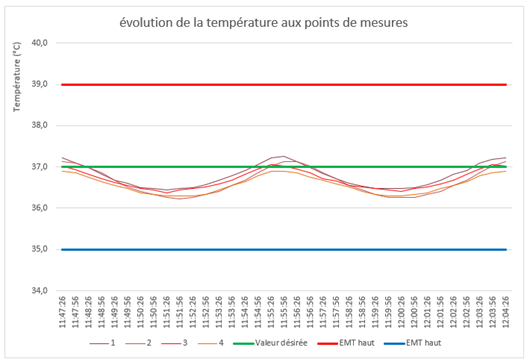
Example of an established regime for a setpoint of 37 +/- 2 ° C

Temperature disparity, uncertainty (measurement + stability) and compliance at each point
4. Trials program
It has been shown that current centrifuge technologies only allow a limited programme of characterisations representative of the performance of the equipment for its operating range (“non-specific” use). The preponderant impact of the speed of rotation in the regulation of the temperature imposes to qualify each speed-temperature couple (“specific” use).
5. Reference norms
Scope : The equipment concerned by the method is defined by standard NF EN 61010-2-020: Safety requirements for electrical equipment for measurement, control and laboratory use / Part 2-020: Particular requirements for laboratory centrifuges.
Temperature characterization : FD X15-140: Air humidity measurement – Climatic and thermostatic chambers – Characterization and verification: Borrowing terms, definitions, symbols and abbreviations; Standard EN 60068-3-5 / 7/11: Environmental tests is suitable for the same use.
6. Additional information on the method of dynamic characterization in temperature of a crown:
Link to a set of videos entitled « The Centrifuge Trilogy »
First episode: general information on centrifuges
Fecond episode: state of the art of temperature measurement in centrifuges


